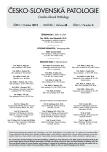Efekt alkoholu na biomembrány v mozku: Přehled
Authors:
I. Komáreková; M. Janík
Authors‘ workplace:
Institute of Forensic Medicine and Medicolegal Expertises, Jessenius Medical Faculty, Commenius University, University Hospital Martin
Published in:
Soud Lék., 57, 2012, No. 4, p. 75-77
Category:
Original Article
Overview
Požívanie alkoholu je celosvetovo rozšírený fenomén, ktorého dopad na ľudský organizmus môže byť fatálny. Dôsledky alkoholizmu sú nielen zdravotné ale aj sociálne a ekonomické. Podstata vzniku závislosti na alkohole ostáva naďalej neúplne objasnená. Predložený článok je venovaný objasneniu mechanizmov pôsobenia alkoholu na centrálny nervový systém na molekulárnej úrovni a jeho interakciám s neurotransmitermi.
Kľúčové slová:
alkohol – fluidita biomembrán – GABA – serotonín – dopamín – neurotransmitery.
Sources
1. Paul SM. Alcohol-sensitive GABA receptors and alcohol antagonists. PNAS 2006; 103(22): 8307–8308.
2. Vengeliene V, Bilbao A, Molander A, Spanagel R. Neuropharmacology of alcohol addiction, Br J Pharmacol 2008; 154(2): 299–315.
3. Ly HV, Longo ML. The Influence of Short-Chain Alcohols on Interfacial Tension, Mechanical Properties, Area/Molecule, and Permeability of Fluid Lipid Bilayers. Biophys J 2004; 87(2): 1013–1033.
4. Huffer S, Clark, ME, Ning JC, Blanch HW, Clark DS. Role of Alcohols in Growth, Lipid Composition, and Membrane Fluidity of Yeasts, Bacteria, and Archaea. Appl Environ Microbiol 2011; 77(18): 6400–6408.
5. Dwyer DS, Bradley RJ. Chemical properties of alcohols and their protein binding sites. CMLS 2000; 57(2): 265–75.
6. Spanagel R. Alcoholism: A Systems Approach From Molecular Physiology to Addictive Behavior. Physiol Rev 2009; 89(2): 649–705.
7. Davis KM, Wu JY. Role of glutamatergic and GABAergic systems in alcoholism. Journal of Biomedical Science 2001; 8(1): 7–19.
8. Davies M. The role of GABAA receptors in mediating the effects of alcohol in the central nervous system. J Psychiatry Neurosci 2003; 28(4): 263–274
9. Koob GF. A role for GABA mechanisms in the motivational effects of alcohol. Biochemical Pharmacology 2004; 68(8): 1515–1525.
10. Moeller FG, Dougherty DM. Antisocial Personality Disorder, Alcohol, and Aggression. Alcoholism: Clinical and Experimental Research 1998; 22(9): 1898–1902.
11. Soyka M, Preuss UW, Hesselbrock V, Zill P, Koller G, Bondy B. GABA-A2 receptor subunit gene (GABRA2) polymorphisms and risk for alcohol dependence. Journal of Psychiatric Research 2008; 42(3): 184–191.
12. Chester JA, Cunningham CL. GABAA receptor modulation of the rewarding and aversive effects of ethanol. Alcohol 2002; 26(3): 131–143.
13. Biggio G, Purdy RH. Neurosteroids and Brain Function. Calif: Academic Press: San Diego; 2001.
14. Morrow et al. Ethanol, HPA axis, and neuroactive steroids. Dialogues in Clinical Neuroscience 2006; 8(4): 463–470.
15. Barbaccia ML, Affricano D, Trabucchi M, et al. Ethanol markedly increases “GABAergic’’ neurosteroids in alcohol-preferring rats. Eur J Pharmacol 1999; 384: R1–R2.
16. Khisti RT, VanDoren MJ, Matthews DB, Morrow AL. Ethanol-induced elevation of 3alpha-hydroxy-5alpha-pregnan-20-one does not modulate motor incoordination in rats. Alcohol Clin Exp Res 2004; 28 : 1249–1256.
17. Matthews DB, Morrow AL, Tokunaga S, McDaniel JR. Acute ethanol administration and acute allopregnanolone administration impair spatial memory in the Morris water task. Alcohol Clin Exp Res 2002; 26 : 1747–1751.
18. Hirani K, Sharma AN, Jain NS, Ugale RR, Chopde CT. Evaluation of GABAergic neuroactive steroid 3alpha-hydroxy-5alpha-pregnane-20-one as a neurobiological substrate for the anti-anxiety effect of ethanol in rats. Psychopharmacology 2005; 180 : 267–278.
19. Adinoff B, Krebaum SR, Chandler PA, Ye W, Brown MB, Williams MJ. Dissection of hypothalamic-pituitary-adrenal axis pathology in 1-monthabstinent alcohol-dependent men, part 1: adrenocortical and pituitary glucocorticoid responsiveness. Alcohol Clin Exp Res 2005; 29 : 517–527.
20. Grace AA. The tonic/phasic model of dopamine system regulation and its implications for understanding alcohol and psychostimulant craving. Addiction 2000; 95(82): 119–128.
21. Anton RF. Pharmacological approaches to the management of alcoholism. Journal of Clinical Psychiatry 2001; 62(20): 11–17.
22. Addolorato G, Leggio L, Abenavoli L, Gasbarrini G. Neurobiochemical and clinical aspects of craving in alcohol addiction: A review. Addictive Behaviors 2005; 30 : 1209–1224.
23. Straka, Ľ., Štuller, F., Novomeský, F., Zelený, M. Dopad akútneho alkoholizmu na mortalitu žien v regióne severného Slovenska. Soud Lek 2009; 54(4): 52–55.
24. Straka, Ľ., Štuller, F., Novomeský, F. Letálne intoxikácie alkoholom a úmrtia v ťažkom stupni opitosti v regióne severného Slovenska v rokoch 1994–1996 a 2003–2005: súdnolekárska komparatívna štúdia. Soud Lek 2008; 53(1): 2–7.
25. Straka, Ľ., Štuller, F., Novomeský, F., Novotný, V. Otravy alkoholom a úmrtia v ťažkom stupni opitosti v regióne severného Slovenska: súdnolekárska reflexia. Psychiatrie pro praxi, Praha, Solen, 2008; 9(2): 80–82.
26. Straka, L., Zubor, P., Novomeský, F., et al. Fatal alcohol intoxication in women: A forensic autopsy study from Slovakia. BMC Public Health 2011, 11 : 924.
Labels
Anatomical pathology Forensic medical examiner ToxicologyArticle was published in
Forensic Medicine

2012 Issue 4
Most read in this issue
- Fatální případ abusu sirupu proti kašli
- Náhlé úmrtí při vzácném mozkovém nádoru: Případ z pitvy
- Dvojí výročí v českém soudním lékařství
- Neobvyklé poranění hlavy a krku ve výtahu
